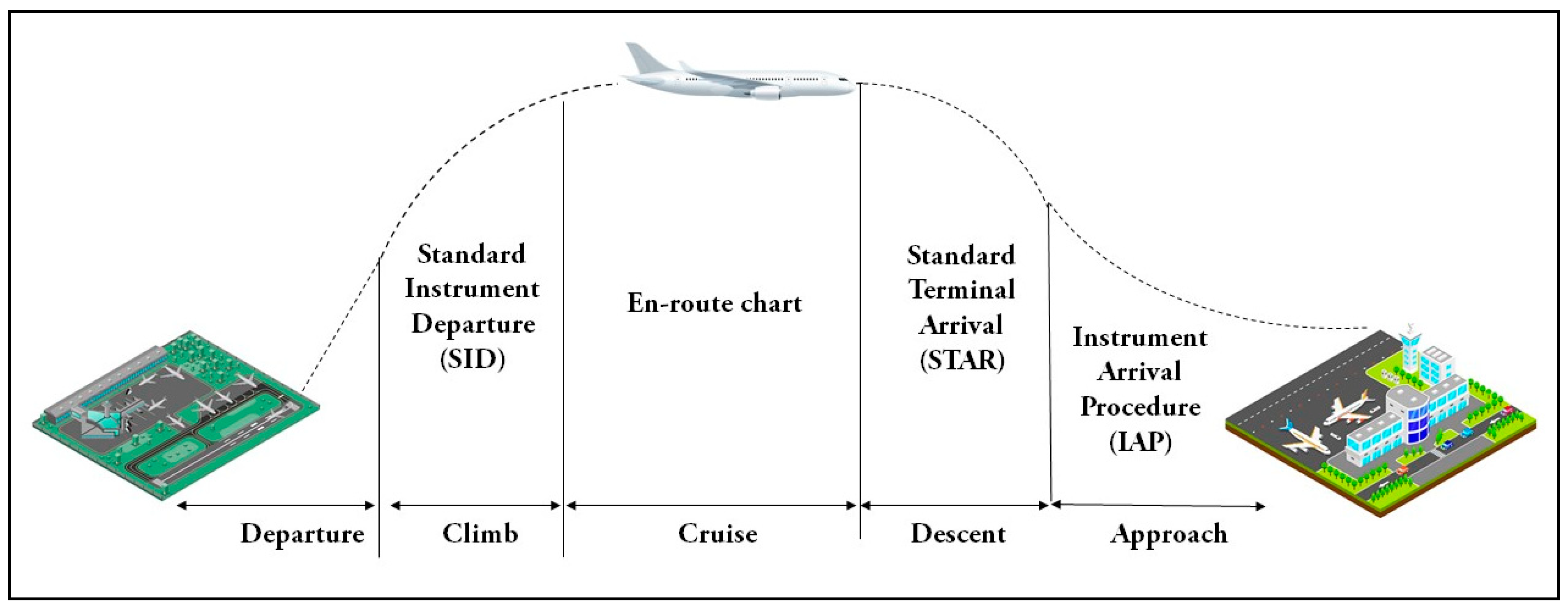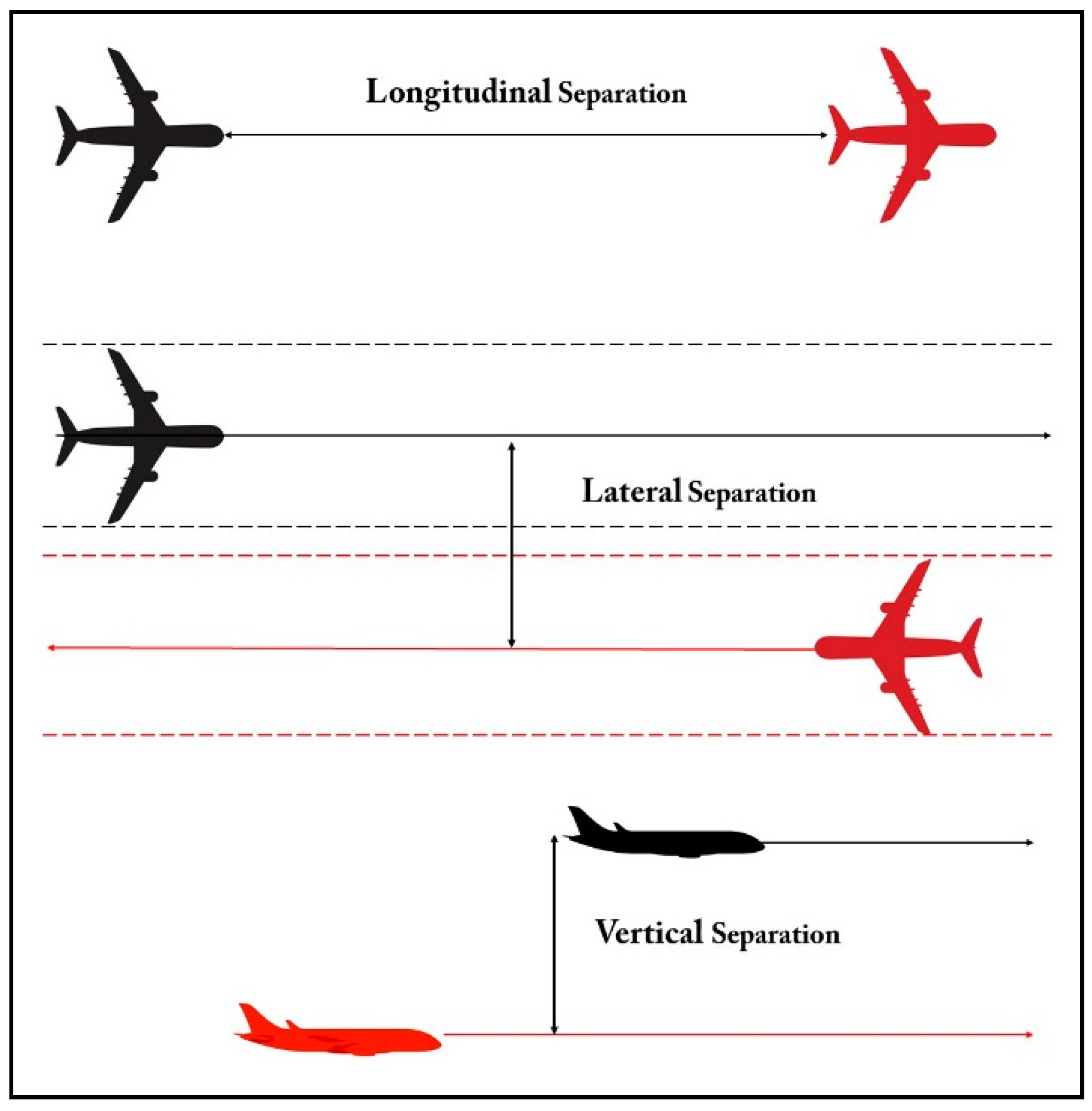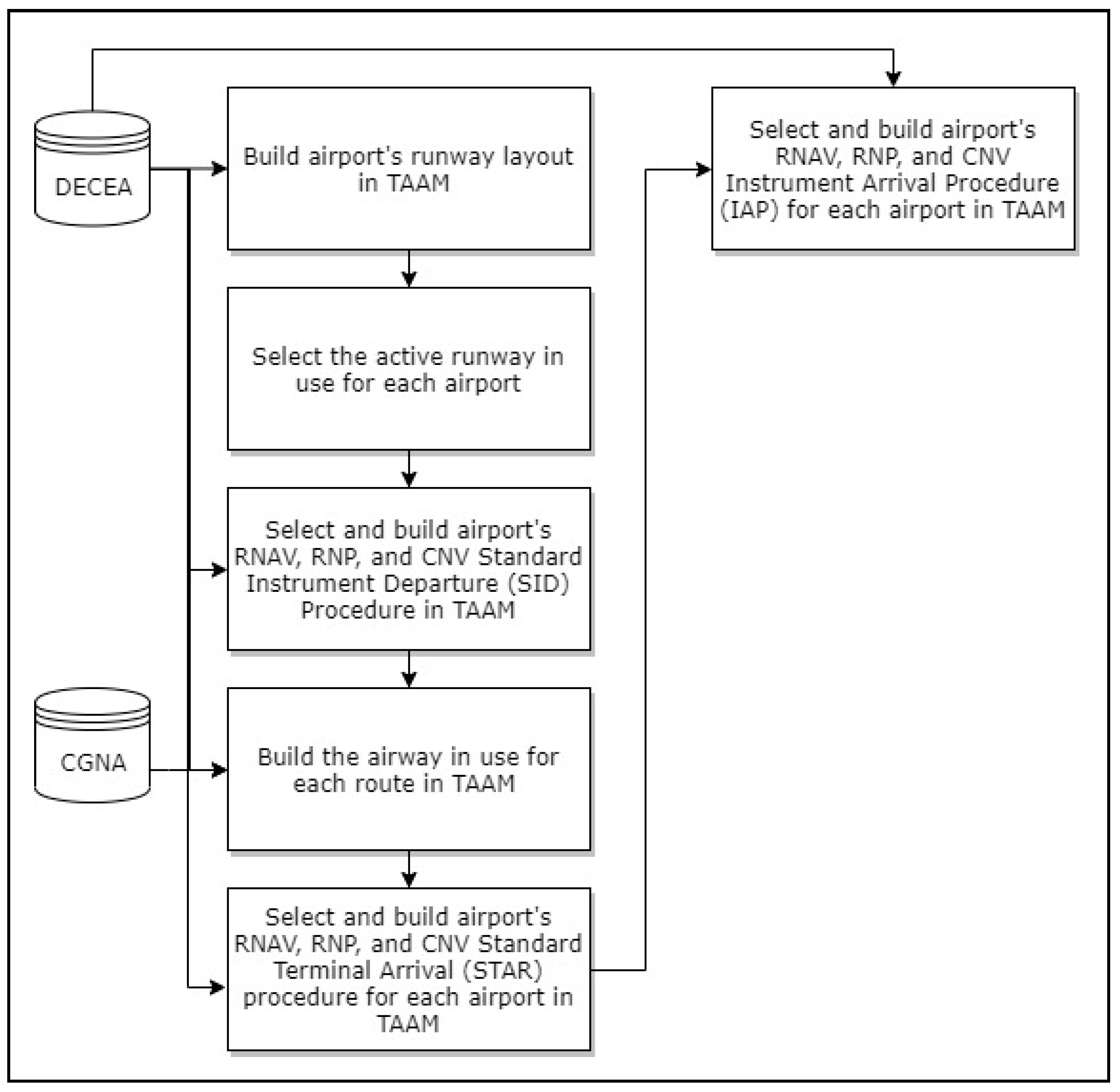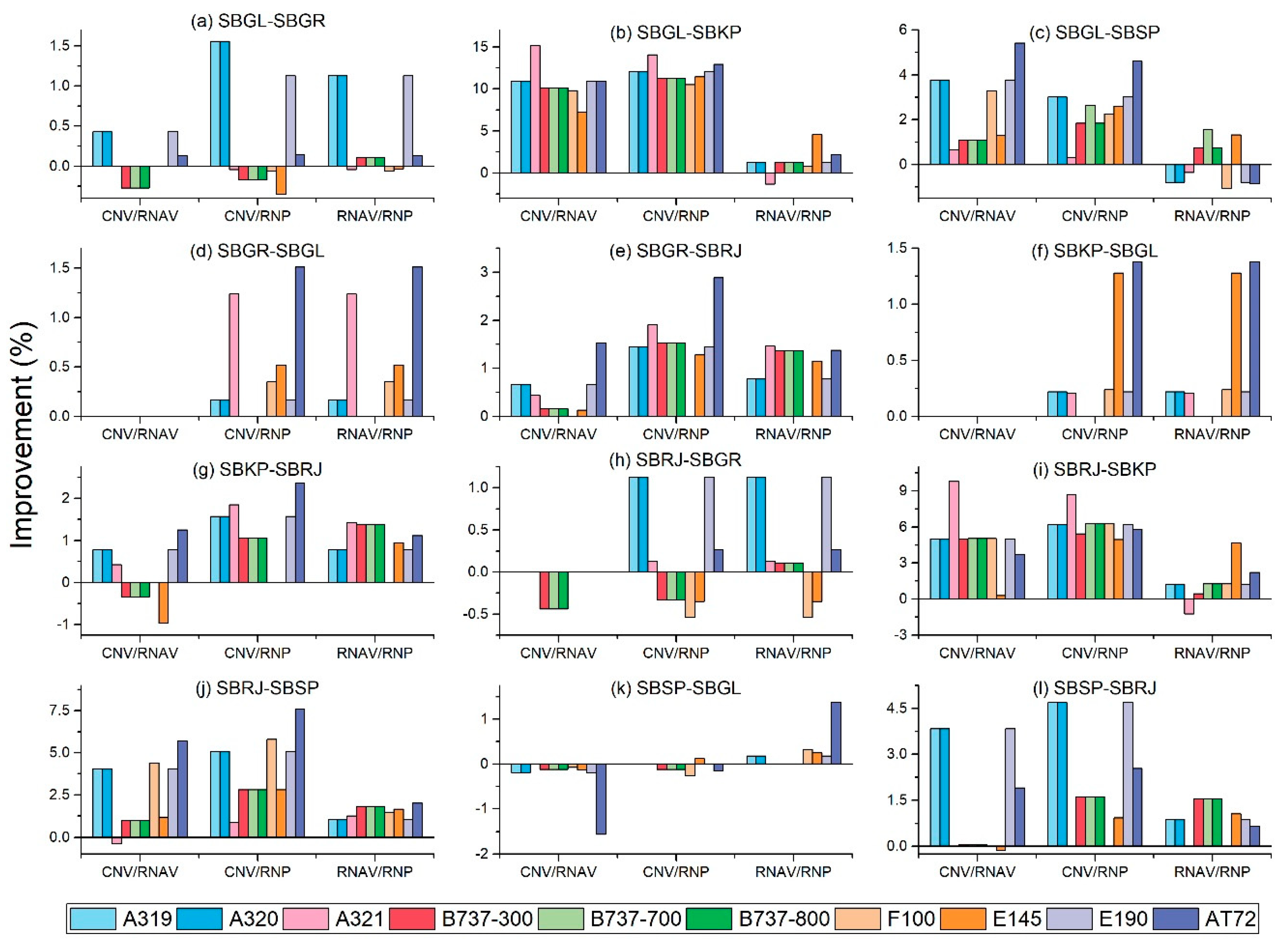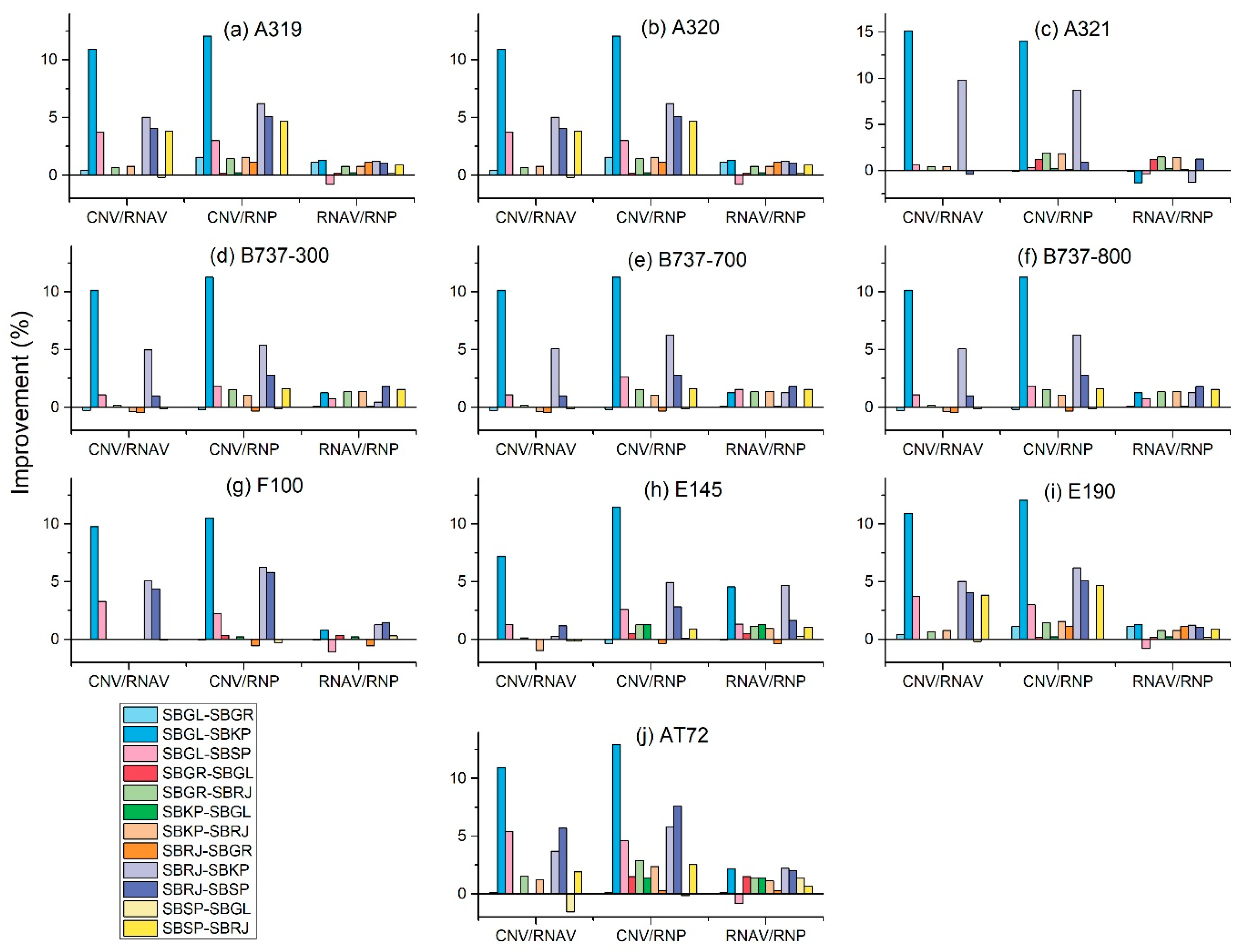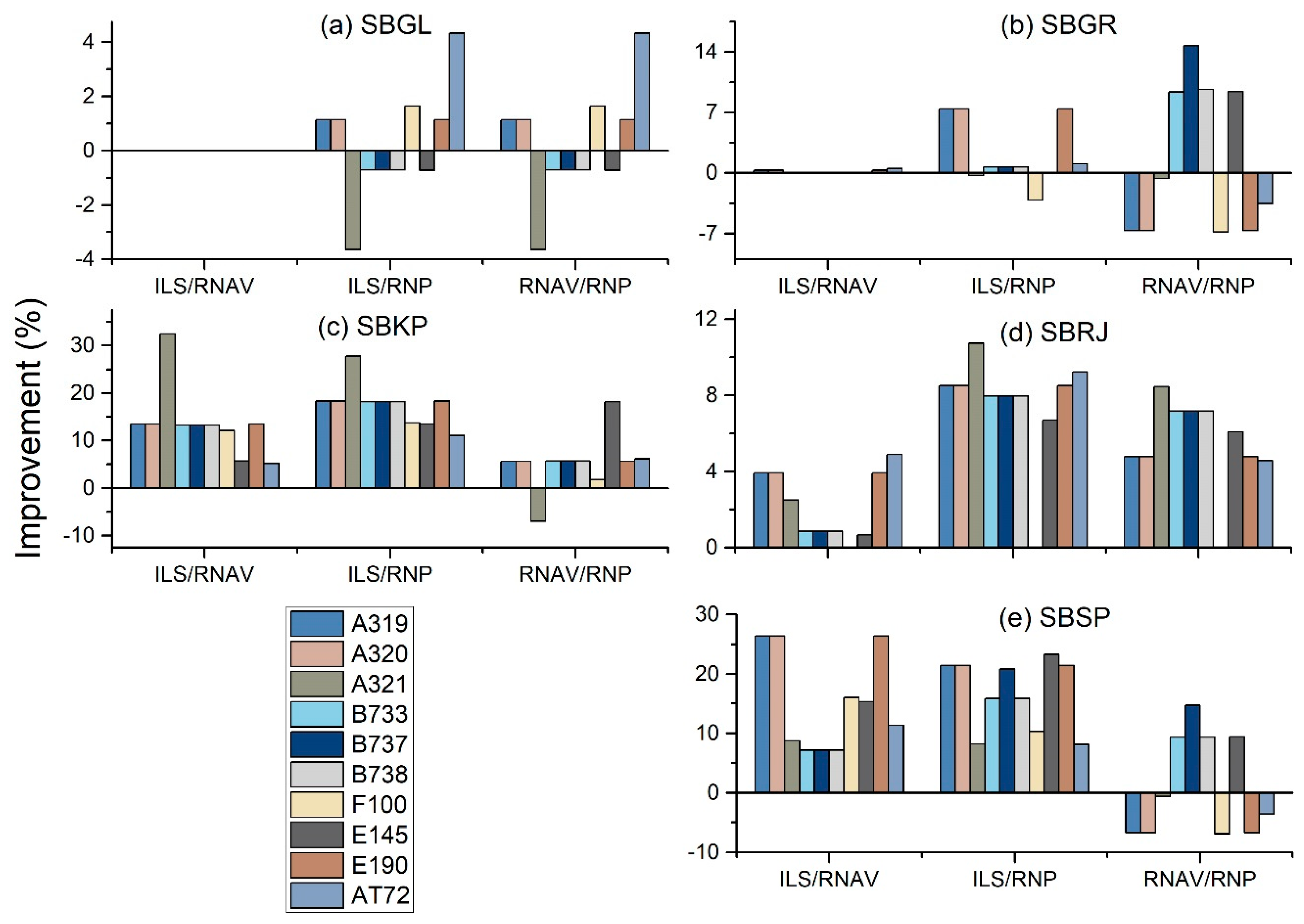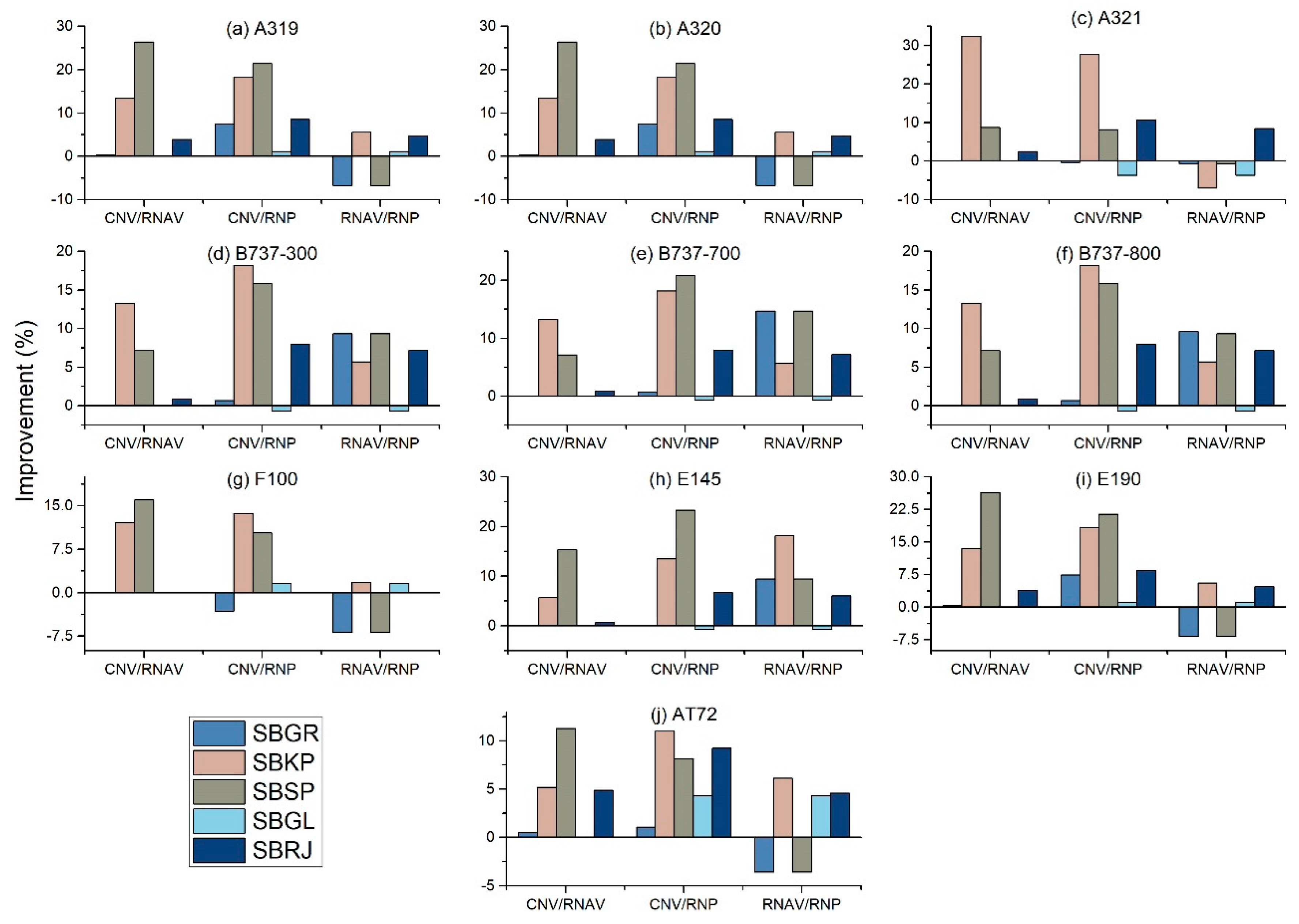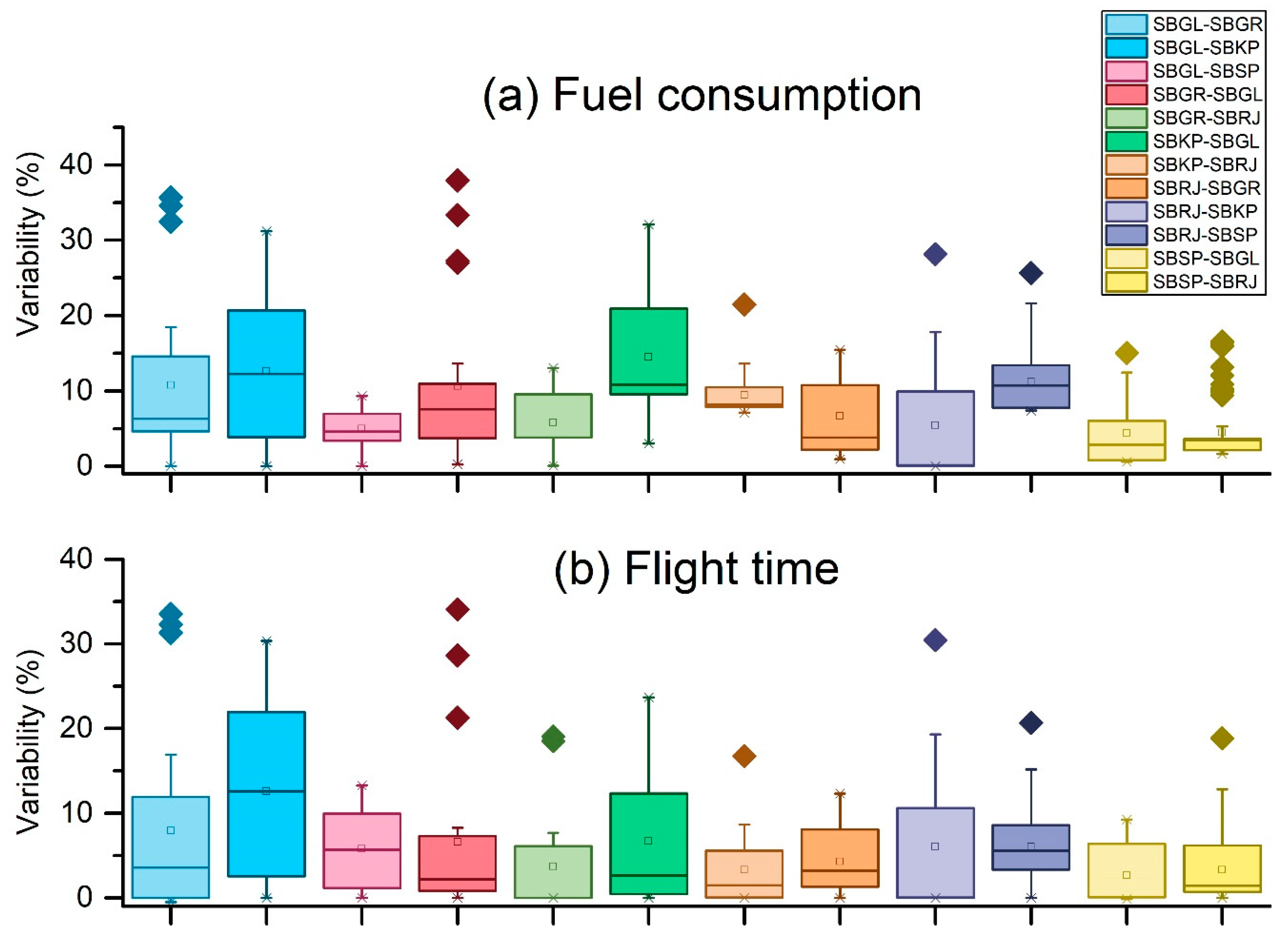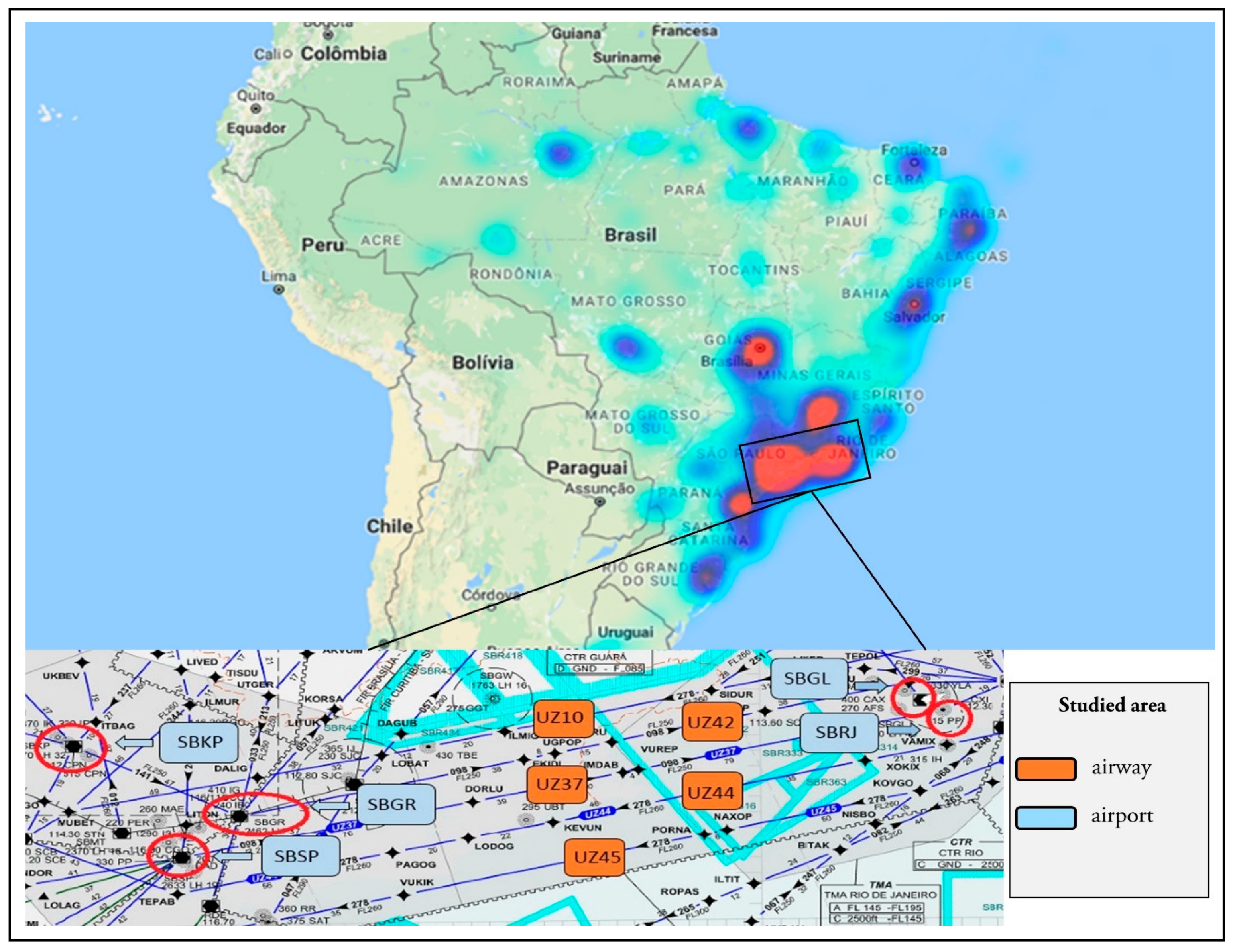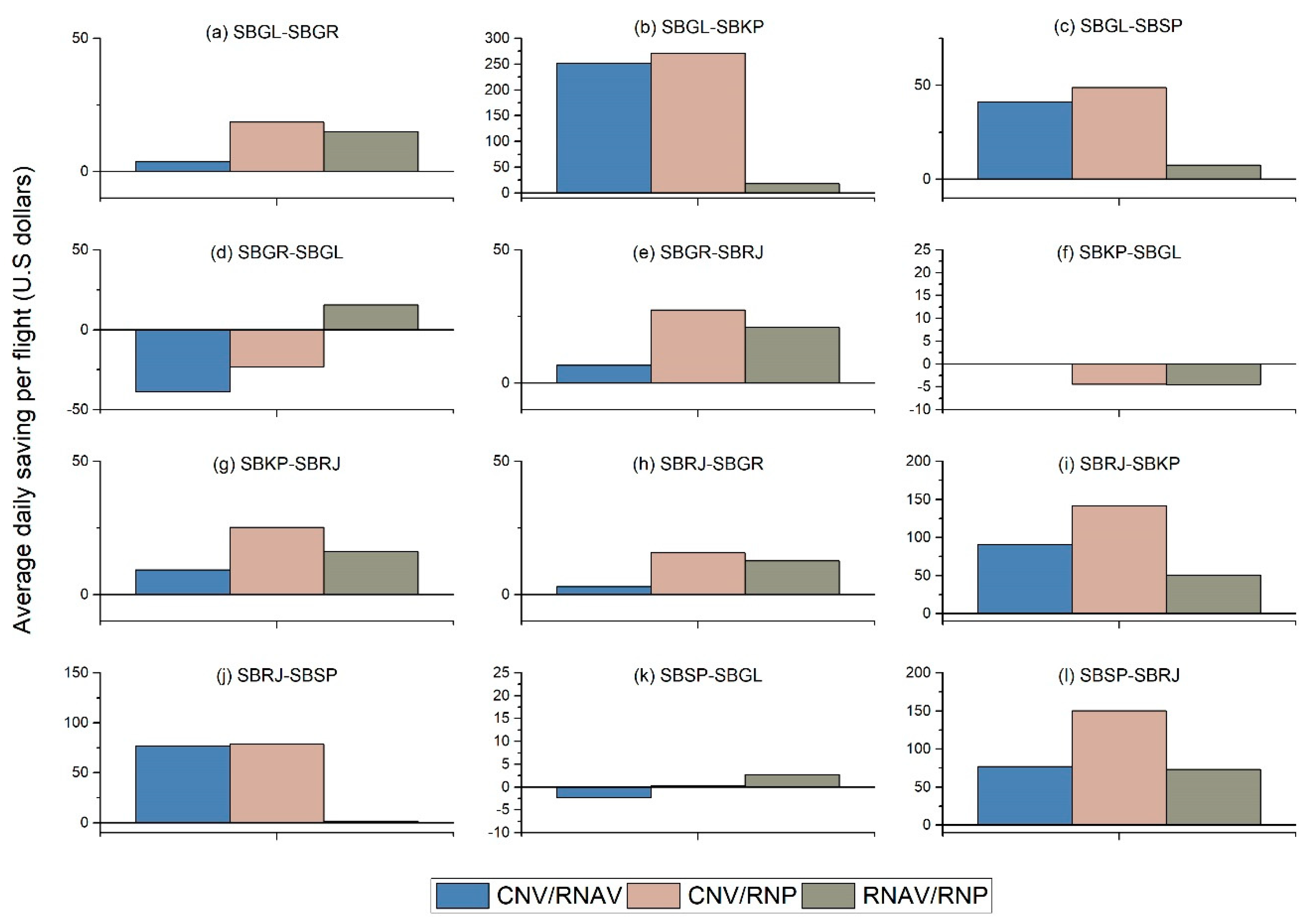1. Introduction
Flight congestion and delays are a significant issue at busy airports. They are a major contributor to air pollution and energy waste, costly for airlines, and a significant inconvenience for passengers. As a result, airlines have faced extra costs and been unable to effectively use available resources in the aviation sector [
1]. To improve capacity and fuel efficiency without negatively impacting safety and the environment, it is essential to develop new strategies for air traffic management (ATM), which will take advantage of present and future technologies [
2].
One of the most important recently developed solutions to these problems is the use of Performance-Based Navigation (PBN) procedures. The International Civil Aviation Organization (ICAO) developed the PBN concept for air navigation. The objective of PBN is to integrate the operational standards of the Required Navigation Performance (RNP) and the Area Navigation (RNAV) approaches. There is fundamentally very little difference between RNAV and RNP, except that RNP systems require alerting and on-board monitoring. PBN is a major component of the NextGen (USA), SESAR (Europe), and SIRIUS (Brazil) programs. These programs aim to implement efficient procedures and an effective use of airspace. In addition, they improve safety, access, capacity and operational efficiencies of the aviation system, thus reducing its impact on the environment.
This study investigates the benefits of PBN procedures at the five major airports in the Brazilian cities of São Paulo and Rio de Janeiro. The benefits are evaluated in terms of fuel consumption and flight endurance. These five airports handle almost 50% of all Brazilian air traffic. A fast-time simulation method was used to compare all PBN operations. This research encompasses all flight routes, including both terminal area (TMA) and en-route airways, individually flying and interacting with other flights. The inclusion of the latter greatly increases the complexity of the analysis, as it includes flights with origins and final destinations other than the five airports in the analysis.
This article expands on the academic literature focused on quantifying the benefits of flying PBN procedures. ICAO claims that the improvements in PBN operation include direct, reduced flight trajectories, lower fuel consumption and reduced negative impact on the environment, and a higher arrival rate at the TMA, among others [
3]. ICAO’s study does not quantify the benefits of PBN. There is a need for studies to fill this gap, using different techniques to estimate the benefits of the implementation of PBN procedures. Although RNAV has many advantages over conventional procedures, RNP can provide a supplementary benefit that cannot be matched by RNAV [
4]. This research measures the benefits of RNP approach procedures comprising radius-to-fix legs, also referred to as RNP Authorization Required (AR) or Special Aircraft and Aircrew Authorization Required procedures. Navigation abilities unique to RNP AR procedures are not available with any other instrument approach procedures; however, these procedures are not widely used due to the high costs associated with their operation. In the U.S., the use of RNP procedures varies widely between airports, ranging from 0.3% at Seattle/Tacoma to 7.56% at New York/JFK [
5]. As their implementation is very recent and not all airlines have the capacity to operate it [
5], few studies have focused on quantifying the benefits of operating RNP procedures [
4,
6,
7]. This research helps to fill this gap.
3. Literature Review
To avoid congestion at the TMA, landing and take-off procedures require an efficient design. [
17]. Flight procedures are not just sets of waypoints. They are important entities in the ATFM environment and should be treated as the unit of analysis. Aircraft behaviour monitoring during their performance is important to understand how the procedures are functioning in the airspace [
18].
RNAV has proven to be advantageous in a variety of TMAs at multiple airports, expanding airspace capacity and achieving efficiency in aircraft operations [
19]. RNAV is also responsible for decreasing the demand for interactions between the pilot and ATC [
20,
21,
22].
Robinson et al. [
23] used controller-in-the-loop simulations to analyse RNAV arrival procedures at Philadelphia Airport (PHL). They ran two simulations and only analyses one aircraft type from US Airways. In the first simulation, all aircraft performed conventional procedures. In the second simulation, RNAV routes were assigned to all aircraft. Flight times, aircraft route dispersion, and distances travelled were examined as part of the analysis. The results showed a three percent reduction in distance and a four percent drop in travel time.
Barker et al. [
24] also used controller-in-the loop to investigate the consequences associated with mixed TMA operations (RNAV equipped with non-RNAV equipped aircraft). They simulated a flow of 42 aircraft per hour. The results showed that the increasing number of RNAV-equipped planes reduced flying distances by 1.8 nautical miles on average, and reduced communication traffic, fuel consumption and variations in arrival times between aircraft.
Sprong et al. [
25] compared RNAV versus conventional arrivals at Las Vegas Airport (LAS). Altitude, arrival interval, and flight time were used as the metrics. Real data from radar were used to generate the metrics, and there was a significant increase in aircraft flight heights in the TMA due to reduced vectoring in RNAV and a pre-programmed vertical profile. This reduced the aircraft fuel consumption. Aircraft experienced decreased lateral track dispersion, indicating that aircraft could fly more predictable and repeatable flight paths. The data also showed no statistically significant difference in airport capacity gain (total throughput) with RNAV compared to conventional procedures, but the standard deviation was lower with RNAV. Flight times and distances could not be compared using the obtained data because of changes in airspace and operations; the authors used simulation modelling instead. The simulation results showed that RNAV procedures reduced the time and distance flown, as well as vectoring.
At Atlanta Airport, Sprong [
10] examined RNAVs and conventional standard instrument departures (SIDs). He validated his work using anecdotal data from airlines. Anecdotal data are an informal way to collect data and relies on personal testimony. The article used radar track data from before and after the implementation of PBN SID procedures. Under RNAV, aircraft often climbed out unimpeded, and flight times were reduced.
Mayer [
26] investigated RNAV departure procedures for Dallas International Airport. The author used the Monte Carlo modeling approach, together with an ATC simulator, to evaluate the operational benefits. The analyses indicate an efficiency gain of 20 extra movements per hour and an average 1.3-min decrease in delay per departure.
Sprong and Mayer [
27] analysed the radar data recorded before and after RNAV employment at arrival procedures for Phoenix Airport. Although the procedures were largely overlaid (conventional and RNAV presented the same horizontal and vertical layout), by combining ATC descent clearances with vertical guidance, continuous arrival descents were considerably increased at the TMA, which resulted in reduced fuel consumption and a 38% decrease in time spent in level flight. In turn, these reductions led to environmental benefits.
RNAV was examined by Timar et al. [
28] as a means of reducing metroplex losses. A metroplex consists of multiple airports with a high level of interdependence in air traffic. They use a queuing system-based approach combined with flight trajectory analysis to measure the increase in aircraft throughput. SIDs and STARs implemented with RNAV showed notable improvements in throughput over previous procedures. The results also showed that the indexes vary according to the types of procedure performed. Procedures of the same type—e.g., RNAV SID—showed different gains compared to a specific procedure’s layout.
Simulations were used to analyse flight patterns over Croatian airspace, Novak and Jurkovac [
29] exemplified how RNAV helps to increase flight efficiency. In their analysis, they simulated two route scenarios: one using conventional navigation procedures and the other using RNAV. The total number of conflicts in each case is used to measure the increase in air capacity and the decrease in flight delays. Conflicts were correlated with flight volume. Under a conventional scenario with a saturated number of aircraft, a maximum of 43 conflicts were recorded. In contrast, in the second scenario with the same setup, a maximum of four conflicts were observed. The ability of RNAV to create additional fixes or waypoints is considered the main reason for the improvement in the air traffic system.
Since RNAV has been implemented for a longer time, most studies focus on the evaluation of RNAV procedures. There is little research into the benefits of using PBN procedures. Muller et al. [
6] report that, when the RNAV and RNP approaches were applied at Sea-Tac, fuel costs were decreased by 40%, but these benefits were only achieved when the routes were optimized. All cases were modelled with a homogenous fleet of Boeing 737-700/800/900s.
Pusateri [
4] describes the advantages of RNP-integrated operations between Boston Airport (BOS) and Washington/Reagan Airport (DCA). Terminal Area Route Generation Evaluation and Traffic Simulation Tool (TARGETS) was used to model and run the RNP simulations. The study estimated reductions of 3:45 min on the route connecting DCA to BOS and 4:30 min on the route connecting BOS to DCA per operation. To estimate the benefits of the proposed RNP procedures, an aircraft flying with an operational cost of
$75.27 per minute was used. The cost savings per flight were
$282 from DCA to BOS and
$338 from BOS to DCA.
Belle and Sherry [
7] analysed the implementation of RNP at Chicago Airport (MDW). The benefit analysis estimated total potential benefits using the surveillance track, weather and operational data combined with a fuel burn model. The results show a potential average annual savings of 17,600 gallons at MDW.
Our study differs from previous ones for several reasons. Earlier studies concentrated their analysis on the departure phase [
9,
26], route phase [
29], or arrival phase [
9,
23,
24,
25,
27]. However, this approach does not consider the interaction and correlation of several flight phases. For this reason, we add to the existing body of knowledge by simulating all flight phases. Although Pusateri [
4] also measures the benefits for all flight phases, we improve on his work by not restricting the investigation to a single aircraft model.
Previous studies focused only on the implementation of RNAV procedures [
9,
23,
24,
25,
26,
27,
28,
29], or RNP procedures [
4,
7]. The present study includes both RNAV and RNP. Although Muller et al. [
6] also spotted both procedures, our study was able to capture the effect of the dynamic interaction between aircraft while flying PBN using a fast simulation, and quantified the benefits for several aircraft models.
Most studies focus only on a single airport, such as the studies conducted at the Philadelphia International Airport [
23], Las Vegas International Airport [
24,
25], Atlanta Hartsfield-Jackson International Airport [
9], Dallas-Fort Worth International Airport [
26], Phoenix Sky Harbor International Airport [
27], Seattle-Tacoma Airport [
6], Boston Logan International Airport [
4] and Chicago Midway airport [
7]. Our study captured the effects of PBN at five major Brazilian airports. Together, these five airports account for about 43% of the total Brazilian air traffic, with 91.8 million passengers per year.
4. Modeling of PBN Procedures
This research estimates the benefits of PBN procedures implemented at five major Brazilian airports: São Paulo/Congonhas (SBSP), Campinas (SBKP), São Paulo/Guarulhos (SBGR), Rio de Janeiro/Santos Dumont (SBRJ), and Rio de Janeiro/Galeão (SBGL). The simulation compares the performance metrics of the PBN (RNAV and RNP) procedures with conventional procedures.
Two scenarios were explored in our research. Case 1 simulated an aircraft flying an established airline route in isolation and measured the minimum fuel consumption. In Case 2, an aircraft flies a typical day and experiences normal air traffic interaction with other aircraft. In Case 2, the simulation was built using the dataset for departing and arriving flights, and the route plan included the aircraft using the five studied airports and the aircraft passing through the studied airspace. In the studied airspace, there were about 4000 commercial flights per day. This research investigated whether the benefits gained in the isolated Case 1 were still achieved in the normal scenario in Case 2. For Case 1 and Case 2, all RNP approach procedures are of the RNP AR type.
For this research, we used the datasets provided by the Brazilian National Agency for Civil Aviation and the Brazilian Department of Airspace Control. For the simulation analysis, we used Jeppesen’s Total Airspace and Airport Modeler (TAAM) software. TAAM simulates in fast-time the operations of airspace and airports [
30]. Before running the fast-time simulation, we built the air traffic scenario and the flight schedule. Finally, we analysed all the results.
4.1. TAAM Model
Although TAAM is a fast-time simulator for air traffic analysis, we needed to build the simulated scenarios in the software.
Figure 3 presents the flow chart used to build the TAAM scenario.
First, we constructed airport runways. Since we did not investigate the effect of airport congestion on the ground (taxiways and aprons), the simulation began and ended at the runways. The simulation process started at the selected runway and the aircraft acceleration for take-off. For each runway at an airport, there are two possible flight directions for aircraft operations. The scenario considers 12 routes that link the five airports. Even though there are about 20 possible routes, the routes between Rio de Janeiro/Galeão and Santos Dumont were not considered in this research because the two airports are very close and traffic between them is almost non-existent. The maximum distance between the airports in the study is 387 km. For each route and selected runway, we chose the SID, STAR, and IAC procedures. Then, we implemented these procedures in TAAM. To select the airways, we used the repetitive flight plans provided by the Brazilian Air Navigation Management Center—referred to as CGNA in
Figure 3.
4.2. Flight Schedule
A total of 10 aircraft types were considered: ATR (ATR72), Boeing (B737-300, B737-700, B737-800), Airbus (A319, A320, A321), Fokker (F100), and Embraer (E145, E190). We built two different timetables. For Case 1, since each aircraft flies in isolation, we scheduled each aircraft to start and finish its simulated flight before encountering another aircraft. For Case 2, where a whole system is simulated, the departure times and respective origins and destinations were based on the Brazilian Air Transport Schedule database of a busy weekday. Times were converted to GMT standard time. The air traffic routes, aircraft model, and flight levels were based on the Brazilian repetitive flight plan database. For this reason, only aircraft in the medium category were included in the analysis of the results. Furthermore, it was assumed that, during a specific simulation, all aircraft and crews were qualified to operate the air navigation procedures; and all the NAVAID infrastructure required for a procedure was available.
4.3. Analysis of the Simulation Results
Flight time and distance are considered classic metrics, and lower values of these metrics indicate better results [
25]. This work considers fuel burn and flight time to determine which procedure minimizes the costs of each type of aircraft flying a specific route. Case 1 obtains the best results regarding fuel burn. Comparing Case 1 to Case 2, we determined the inefficiencies of congested air traffic systems that had a PBN procedure and those that had a conventional one. To evaluate fuel consumption, TAAM uses the Base of Aircraft Data (BADA) to obtain the fuel consumption of each airplane. BADA is EUROCONTROL’s aircraft performance model.
During the study, the TAAM “aircraft performance randomization” function was disabled, and the mass levels were set as nominal to ensure that, when performing the flight procedures to be compared (RNP, RNAV, and conventional), a specific aircraft model maintains the same parameters, such as maximum take-off weight, departure time, descent start point, and landing touch point.
For instance, consider a situation in which we would like to examine the efficiency of a B737-700 performing a RNAV, RNP, or a conventional procedure on the route between SBGR and SBGL. We will need to run three simulations (one for each procedure type). Since the “aircraft performance randomization” function is disabled, all the performance parameters will be the same for the B737-700 during the three simulation runs. All the flight’s duration and fuel used differences will be connected to the aircraft performance during a determined flight procedure (RNP, RNAV, and conventional).
As the two parameters were adjusted for all aircraft, the differences in flight duration and fuel consumption between aircraft types performing the same flight procedure are linked to the aerodynamic and performance characteristics of a specific aircraft.
The results were measured in terms of percentage of improvement from the sum of all flight phases that the simulated flight must follow (
Figure 1). We used Equation (1) to calculate the gains from one procedure compared to another procedure:
where A and B can be PBN (RNP or RNAV) or conventional procedures.
In addition to the metric presented at Equation (1), researchers used other metrics, such as the ratio between the total distance flown and the direct distance of a given flight [
31]. Studies of this type compare the observed distances (radar data analysis) with theoretical estimates (great circle distance). Due to the unavailability of this type of information for the present study, we chose to use the metric provided in Equation (1).
6. Conclusions
Flight inefficiency remains a contributing factor to airline costs and passenger dissatisfaction. This reality highlights the need to mitigate this, and modernize the national airspace worldwide. One of the proposed solutions is the implementation of PBN procedures.
In this study, the application of the PBN procedures is evaluated for the Brazilian airspace system. Two cases were analysed. Case 1 simulates and quantifies the benefits of the introduction of the PBN procedures. The results show that the benefits are neither constant nor linear considering the type of aircraft and the procedure layout. Possible yearly savings of up to US$ 271 per flight were identified. Case 2 assumes the aircraft are in a normal air traffic situation and interacting with each other. On average, compared with Case 1, the aircraft losses which depended on the time of the day.
This study found that the introduction of PBN procedures brought benefits related to fuel burn, time and cost savings for different aircraft models. PBN procedures have improved air navigation. They allow for better route-planning, and the procedures do not depend on ground-based approaches. In an isolated scenario, the results showed that the benefits changed depending on aircraft type and procedure layout. In a normal air traffic situation where aircraft interact with each other, compared with the isolated scenario, the aircraft had, on average, losses due to interaction with other air traffic. This research shows that the savings are variable, as they are a function of the route and aircraft type. The PBN procedures are, therefore, an important step in the modernization of the airspace system, contributing to improvements in the efficiency of the air sector.
The introduction of the PBN procedures has been a breakthrough in air navigation. Its introduction allows for better planning of the routes, reducing the dependence on conventional approaches. This article considers fuel consumption and flight time as the key parameters to compare different procedures. Other parameters, such as the total number of air traffic conflicts and ATC controller workload, should be considered in future studies. Further studies should also evaluate if the gains obtained in this study are achievable in other airports around the world. With the projected demand for air transportation in the next decades, PBN procedures are an important step to modernizing national airspaces worldwide and improving the efficiency of the air sector.
